Menu
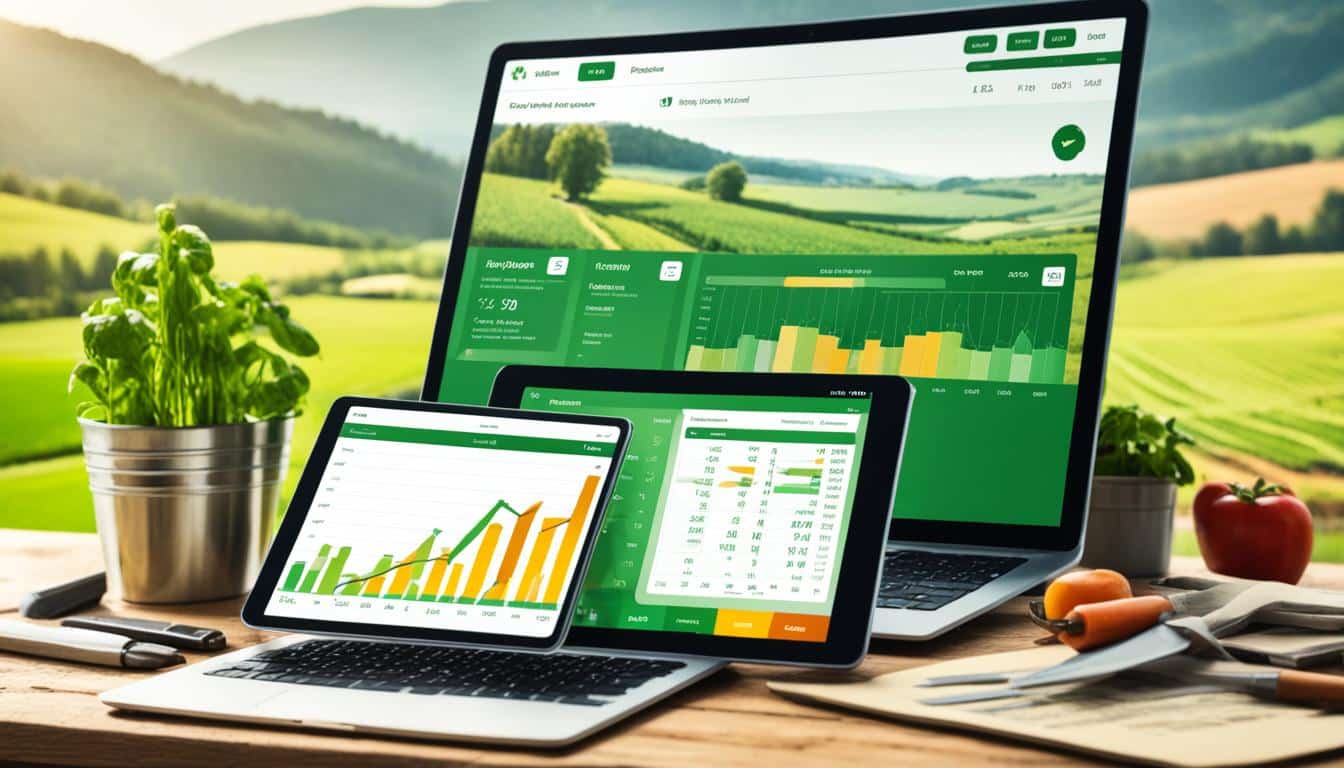
Did you know FarmERP has handled more than 600,000 acres of farmland in over 30 countries? This shows how much digital tools have changed farming. These tools help farmers understand their land and crops better. They also help with risk and market trends, making farming more profitable and stable.
Digital tools for farm finances focus on making farms financially healthier. They cover everything from better soil to smarter spending. This broad view of farm operations helps farmers deal with unknowns in nature. Now, with technological help, farmers can use their resources better to earn more.
Using digital tools in farming has changed the way we operate. Take Nigeria, for example. It boasts 149 million active mobile subscriptions and 92 million internet users. This has opened up new opportunities in the agricultural sector.
In 2015, farming made up around 20% of Nigeria’s $481 billion GDP. This was thanks to a boost in food production and less dependence on imported food. This shows how digital tools have made a big impact.
Digital advances in farming finance are key to a healthy future for agriculture. They allow for quick data checks, future trend guesses, and smart use of resources. In Nigeria, projects like RUFIN have made a big difference.
RUFIN helped raise N66.6 million in savings from 31,000 people. Nearly half were women. Because of this, more people could get loans. This has changed things a lot, showing the power of digital solutions.
Digital tools help farmers handle their money better. Nigeria has lots of land that isn’t being used. With digital planning, farmers can make the most of their land. This boosts what they can grow and earn.
Thanks to digital connections, more farmers can now get loans. Just in one example, Rural Microfinance Institutions gave N134 million in loans. This shows how vital digital tools are for farmers everywhere.
“Smallholder farmers frequently lack the required investment capital and access to financial services.” Combining digital financial innovations with actionable information is crucial.
But, there are still challenges. We need better ways to share information and work together. Groups like ICT4ag are pointing out ways to improve. By using the latest digital trends, we can help farmers and the poor in rural areas. This will build a better future for farming.
Digital farm budgeting systems offer big advantages to today’s agriculture. They boost efficiency and accuracy with their smart, automatic processes and effective data handling. By integrating real-time data, they help in quick decision-making and keep financial records spot-on and current.
These digital systems cut down on time-consuming tasks by automating them. This gives farmers more time for planning and carrying out their strategies. Plus, they make financial reports more reliable, aiding in making smart choices. Think of it like this: special farm software can help with feed processes, keep track of materials, and handle feed mills.
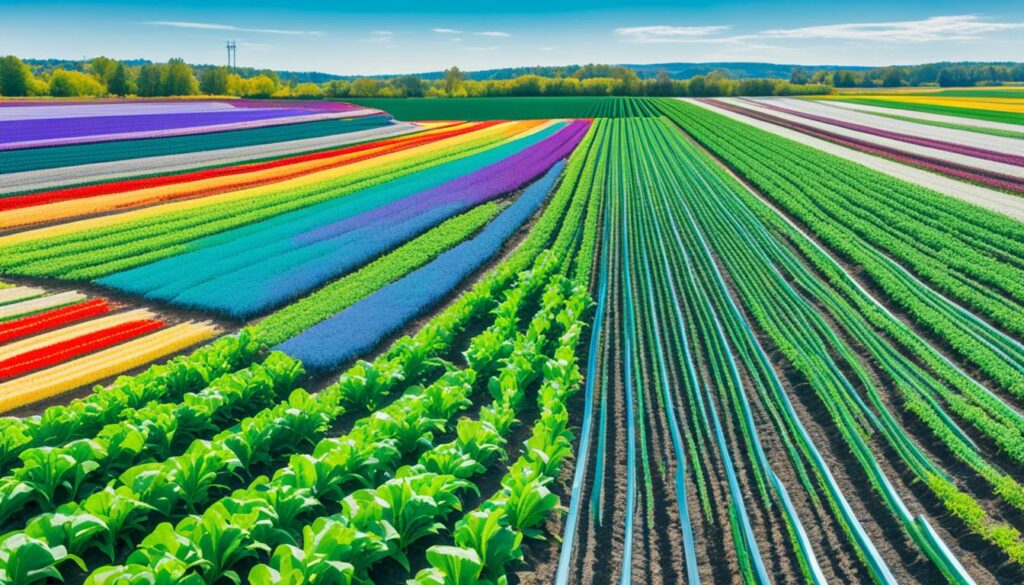
Knowing what’s happening is key to proactive farming and being answerable. Farm management software offers detailed analytics and reporting. This gives all involved a clear view of the farm’s financial health right now. This openness helps build trust and ensures money matters are under constant positive change. With a ton of reports and dashboards available, managing legalities and certifications is easier than ever.
Going digital can lead to saving a lot of money. It cuts down on admin work, which means less money spent on workers. Plus, having exact financial info helps farmers put their resources and costs exactly where they’re needed. This makes it easy to spot and fix money-wasting areas. Also, selling online is smoother with farm software, boosting earnings.
Technology has changed farming, and now, many farmers use farm management software. These digital tools help farmers manage their finances by covering all aspects of a farm. They connect financial management to production, risk, and managing people. The software available now makes farm work more efficient and productive.
Comprehensive farm management systems bring all farm jobs into one easy-to-use platform. They do more than just handle money; they also deal with how the farm makes things. They help farmers see the money coming in and going out. Popular systems, like those from ClimateAi and Trimble Ag Software, manage things like picking crops, watering, looking after animals, and mapping.
Systems, ClimateAi and Trimble Ag Software, let farmers do different jobs all in one place.
Specialised financial tools focus on key areas such as accounting, managing crops, and keeping machinery working. Farm accounting software makes financial tasks easier with automatic operations and clear reporting. Products from big names like AgriWebb and FarmLogs really help with managing livestock and checking on field health.
So, farm finance software comes with many helpful tools. These range from complete systems to specific platforms. They all aim to make the farm work better and more sustainably. Using this software, farmers can save on labour costs and make smart choices for the future.
Farm financial management is changing fast through digital solutions. These solutions now provide many tools farmers need for success.

Key parts of these solutions include:
Advanced solutions go further. They use data to help with crop rotation, improve soil, and forecast weather. This aids in making smarter plans and understanding the farm’s finances better. They are essential for managing a farm’s business well.
| Feature | Description |
|---|---|
| Financial Tracking | Monitors cash flow, tracks income and expenses, enabling well-informed investment decisions. |
| Inventory Management | Maintains detailed records of stock levels, ensuring optimal resource allocation. |
| Predictive Analytics | Uses historical data to forecast trends in crop performance and financial health. |
| Weather Forecasting | Integrates weather data to plan activities, minimizing risk due to climatic variations. |
| Labour Cost Management | Tracks labour expenses, enhancing efficiency and operational effectiveness. |
These financial tools are crucial in modern farming. They help farmers work better and smarter. With the right digital solutions, farmers can boost their earnings and farm more efficiently.
Digital tools for farm financial analysis bring advanced tech to farming. They boost efficiency and productivity. This helps face globalisation and changing markets better.
Digital tools include soil and crop monitoring. Using special software, farmers watch soil and crop health closely. This helps use resources better, save money, and forecast what’s coming. ClimateAi is great at predicting and suggesting what to do for better crops and the environment.
Market and risk analysis is also key. A good farm management system helps understand the market and deal with risks. It looks at things like market prices and the environment. By managing money smartly and using digital tools for financial analysis, farms can secure their future.
“Using digital tools in agriculture combines old farming wisdom with new tech. It helps farmers make smart choices while using resources well.”
So, using digital tools in farming is a big change in how farms are run. It helps keep farm incomes good and supports the future of farming.
Global agriculture faces more risks like droughts and floods. This makes it vital to use digital farm financial management systems. I’ll look at two cases that show the benefits of these systems.
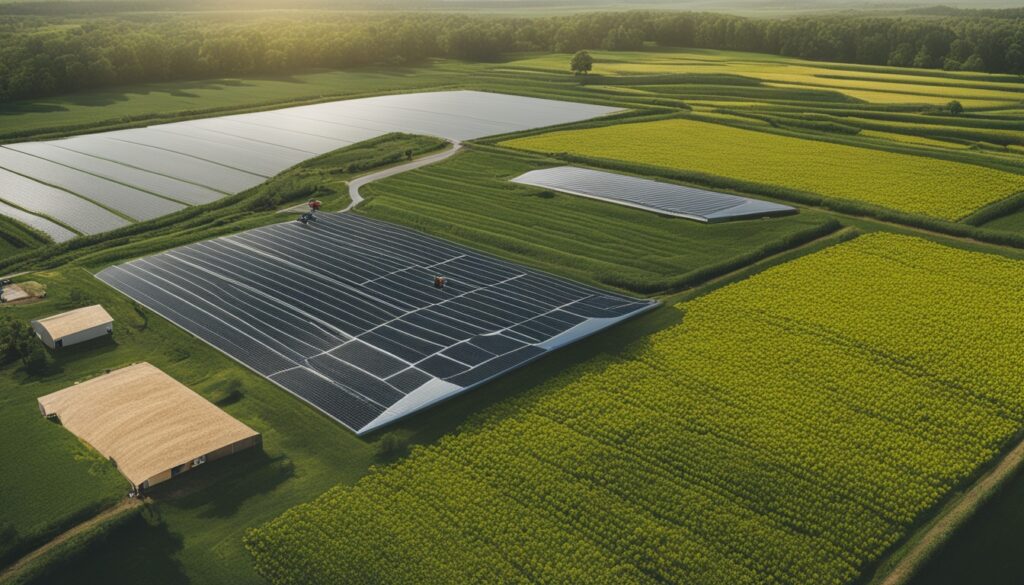
Corteva Agriscience has a great system called Carbon Initiative. It helps farmers make money from their land’s health. Farmers earn from improving their soil with carbon credits. This way, they manage their money and help the planet too.
Many farmers are using Trimble Ag Software with great success. It has everything for managing a farm, like tracking crops, mapping fields, and accounting. This software helps them do better farming and manage their money well. It also offers weather info and financial reports, making farms more efficient and resilient.
Farming today needs advanced digital tools for better financial control. Key digital farm accounting platforms are now a must. They provide important features for managing farm money well. Here’s a look at what these platforms offer and the benefits farmers get from using them.
Leading digital farm accounting systems cater to farms of all sizes and needs. A good example is QuickBooks Online, priced from $30/month. It links to bank accounts for easy expense tracking. FarmRaise, with a free option and a $36/month premium plan, gives farmers a big list of funding choices.
FarmBooks, available for a one-time buy of $495 plus a $95 yearly maintenance fee, is great for accounts, inventory, and reports. Another, Xero, from $15/month, handles invoices, bills, and cash flow. It meets basic farm management needs well.
| Platform | Starting Price | Key Features |
|---|---|---|
| QuickBooks Online | $30/month | Auto expense population, bank account integration |
| FarmRaise | $36/month | Funding options library |
| FarmBooks | $495 one-time | Accounts management, inventory tracking, financial reports |
| Xero | $15/month | Invoices, bills, cash flow tracking |
| Traction | $79/month | Reporting and data insights |
| EasyFarm | $650 | Additional farm management modules, payroll options |
Farmers using digital platforms say they make better decisions, manage money well, and work more efficiently. For example, Traction users, paying $79/month, praise its strong reports and insights. They also like how easy these systems make managing complex finances.
QuickBooks Online stands out for how well it integrates with other services. This makes financial monitoring and reporting straightforward. These experiences show the value of digital farm accounting systems in running farms better. They offer more efficiency and clear financial oversight.
Today, technology is key in farm financial planning. Farms are part of a global market. They deal with changing prices and policies worldwide. Thanks to 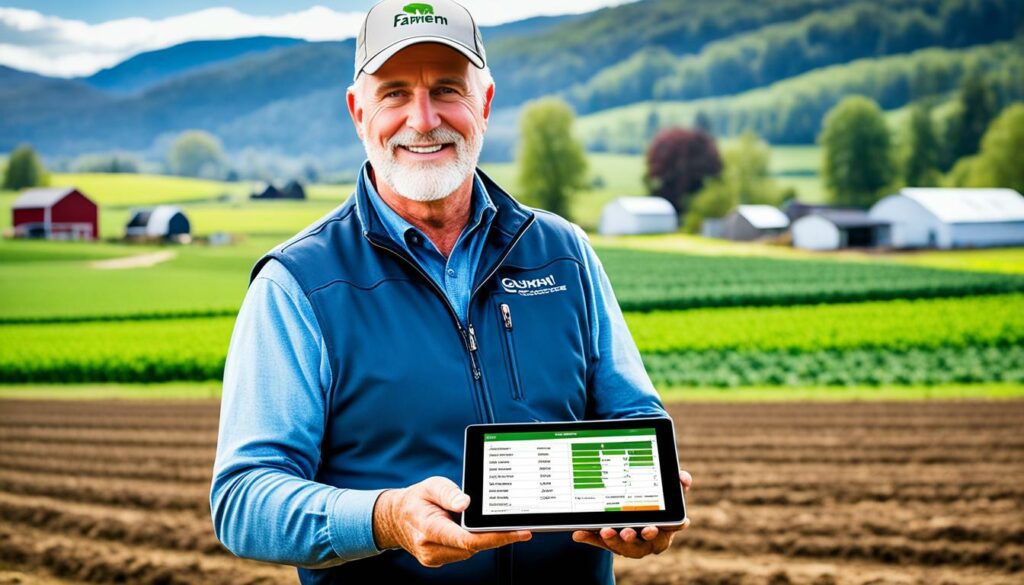
Setting up a farm management system is vital. It pulls together, in one place, everything from finance to risk management. This makes work streamlined, from keeping records to planning, making farms more efficient. Software like Climate Smart Agriculture helps by offering weather predictions.
Farm software does more than track money. It plans what to grow, keeps an eye on weather, and manages equipment. Brands like ClimateAi and FarmLogs have tools for different farming needs, like tracking crops or planning irrigation.
High-tech systems help make smarter choices. By using data from ongoing crop checks, for instance, farmers can make better decisions. They can adjust their use of things like fertilisers, seeds, and weed killers. This helps them farm more effectively in different conditions.
But, many farmers need to learn more about capital budgeting tools. These are vital for smart financial planning. By using tech for planning, farming businesses can grow. This way, they can be both profitable and last a long time.
Tech also helps save money on fuel and labour. It makes farming operations more precise and efficient. It’s not just about the money, though. By using AI and advanced tech, farms can be kinder to the planet. This is good for food security and the environment.
Farmers today need technology to manage a complex industry. With the right tech tools, they can secure their futures and the land for the long run.
Farmers are now using digital tools to watch how their farms are doing financially. These tools help track Key Performance Indicators (KPIs). They show farmers important financial facts and can spot areas to work on. This helps farms make more money and be kinder to the environment.
Looking at KPIs is key for a farm’s success. More and more, farmers are using technology to keep an eye on their finances. They look at things like how much they grow, what it costs for labour, and how they use their equipment. Tools like Trimble Ag Software and FarmLogs help them measure their success and change their plans as needed.
Getting data in real-time is very important for modern farms. It lets farmers use information like soil health and market trends right away. This helps them deal with changing crop prices and politics that affect farming. Being able to react quickly is vital for many farms.
| Software Platform | Key Features |
|---|---|
| ClimateAi | Weather monitoring, crop forecasting |
| FarmLogs | Activity planning, crop management |
| Trimble Ag Software | Financial accounting, GIS mapping |
| Granular | Risk management, financial analysis |
| AgriWebb | Livestock management, inventory tracking |
AI is now improving how we watch and understand farm finances. These AI models look at a lot of information, like money matters, how the farm is doing, and even large economic trends and personal details. By 2030, farms may be making more than two million data points a day. This shows how essential AI is becoming for farming finances.
As we wrap up, it’s clear that digital tools are changing how we manage farm finances. They offer a great view of money matters and help farmers in their choices. These tools are at the heart of good financial management for farms. They’re helping farms make more money and be more sustainable.
In today’s farming world, keeping digital records safe is crucial. As more farmers use digital tools to manage their money, it’s important to protect their information. With the precision farming market growing, there’s more risk of data being exposed. So, better security is necessary.
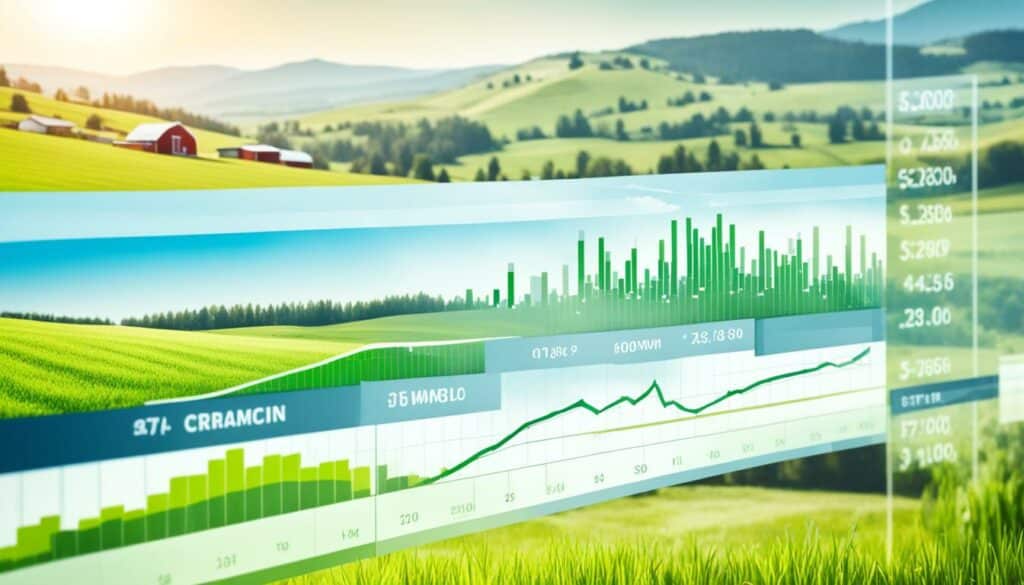
To keep data safe, it’s key to use encryption and limit who can access it, plus check security often. These steps are vital in stopping hacks and protect against most security breaches in farming being due to mistakes by people.
Farmers across the world worry they might not be able to stop cyber attacks. This anxiety shows up in surveys, like in Finland. It shows how important safe digital tools are for managing farm finances. These tools should have strong security to keep info safe.
Farming is part of a global market now. This makes the industry more prone to price changes and policy shifts. Using secure digital tools helps farmers cope with these issues better. It’s important they pick the right digital tools that not only help with money but also keep it safe.
By using safe digital tools, farmers can handle their money better. These tools help keep track of spending and make plans. But, it’s vital to choose tools that have good security, to protect the farm’s finances and keep business going.
The way farm financial management is handled is changing fast. New technologies like artificial intelligence (AI) and machine learning are making a big impact. They improve how we analyse data and do complex tasks. This change will make farm financial systems work in very new ways.
AI and machine learning play a key role in this change. Forbes found over 200 AI-focused startups in the U.S. for agriculture by 2023. These new techs help farmers understand markets and the weather better. This leads to smarter choices in what crops to grow and how to plan financially. They can also spot patterns in big data that are hard to see normally.
Blockchain technology is also becoming more common in farming. It makes financial deals and supply chains more open. Every deal is recorded in a way that can’t be changed, making things more secure. Farmers can trust their money records more. It also helps keep track of government help, making sure it’s spent well.
These changes are not just making things run better. They are also helping farms stay strong against changes in the market and the environment. The smart farming sector is set to double in value by 2027. Using AI, machine learning, and blockchain is key to this growth. They will help farmers run their businesses in ways that are smart and make sense for the future.
Putting digital tools into farm finances faces many hurdles. These include issues with technology, especially in the countryside, and earning farmers’ trust in new systems. To solve these, we need plans that help with the tech stuff and the people stuff.
Not everyone has the right tools or connection, and some struggle to understand the technology. The answer is to improve internet access in rural areas and make financial management tools easier to use. Moreover, offering training and support would help farmers feel confident using the tech.
Farmers must see the clear benefits technology brings and how it fits their farming needs. To win their trust, the approach should be clear, sharing stories of how others succeeded, and trials of the tools. For them to change their minds, the tools must show they’re worth it.
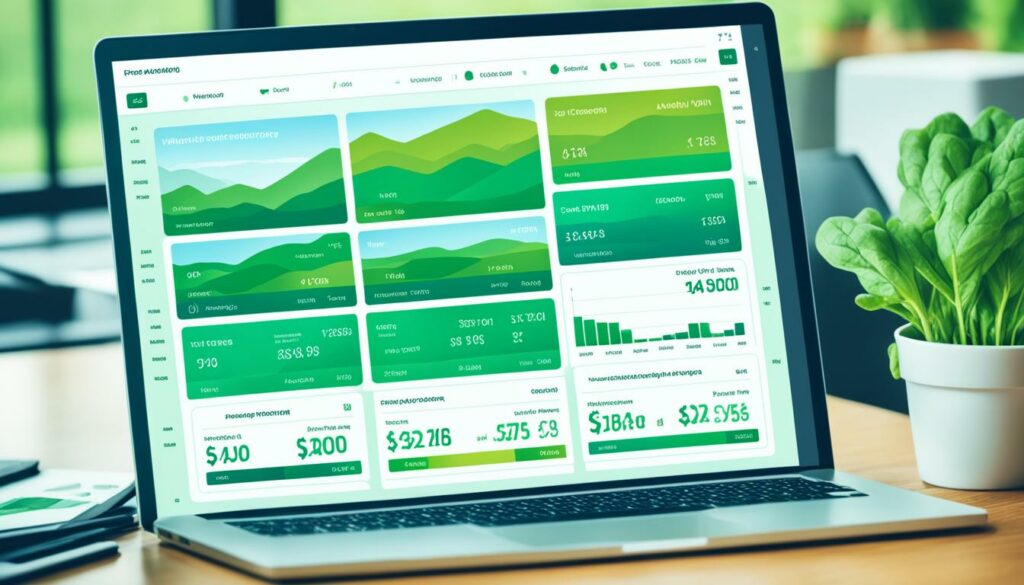
Recent studies provide valuable insights into why farmers might not fully trust or use digital farming solutions.
| Region | AgTech Adoption (%) | Technological Barriers | Trust Issues |
|---|---|---|---|
| North America | 61 | Moderate | Low |
| Europe | 61 | Moderate | Low |
| South America | 50 | High | Moderate |
| Asia | 9 | Very High | High |
Improving digital farming means focusing on building infrastructure, teaching farmers well, and gaining their trust. Facing challenges head-on, the agricultural industry can become more digital and prosperous.
Digital tools for farm finance are changing the game in agriculture. Globalisation and stronger business connections make farming more challenging. With commodity prices and policies shifting, farmers face bigger risks. To tackle these challenges, using modern farm management systems has become a must.
Farm software automates many tasks, making farm life easier. It lets you keep track of stock, create financial reports, and plan crops wisely. These tools cover everything from planning your farm work and managing crops to mapping fields and watching the weather. They help farmers worldwide, where agriculture is their main income.
In the US, digital finance tools are vital for managing its vast farms. US farmers produced goods worth 136.1 billion USD in 2019, adding up to 1.109 trillion USD income for various sectors. These tools are crucial for small family farms, which are 89% of all farms there. Moving forward, using smart farm tech for planning and managing data will be key. This approach will ensure farms are more resilient, sustainable, and profitable in the future.
Digital farm financial tools help manage money in agricultural works. They make financial tasks better, more accurate, and clear. There’s software for the whole farm, money-focused tools, and digital budgeting systems. These provide data when needed, track trends, and help in planning.
Digital tools have revolutionised how farms handle money. They blend money and day-to-day work, making managing easier and smarter. This change moves farms from old-style ways to using data for decisions.
Digital solutions boost efficiency and cut down mistakes by doing tasks automatically. They let you see your money situation straight away. This saves money by making jobs simpler, and puts you in control financially. They also help you plan smart and make good choices, helping your farm grow and make money in the future.
Digital finance software comes in two sorts. Some cover everything, from making things, to dealing with risks and people, alongside money. Others focus just on finances, like for accounting or looking after crops and machines, giving detailed money reports.
These digital tools help track money, plan what to spend on, and keep a tab on what’s bought and sold. They also make money reports, and look after staff costs. For advanced users, they can predict best times for planting, how to make soil better, and even guess the weather.
Digital tools help understand money by watching over soil and crops, looking at what people want to buy, and guessing risks. They give farmers ideas to make better choices for both profit and keeping the farm running well. Devices like ones tracking soil and crops and checking on market risks help to plan ahead and lessen dangers.
Two well-known systems are Corteva’s Carbon Initiative and Trimble Ag Software. The first pays farmers who boost their soil’s health with carbon credits. The second, Trimble, bundles many tools to make farm work easier, from overseeing plants and animals to mapping and accounting. These show how digital tools can help farms stay financially strong.
The best platforms do more than just watch over money. They help store important papers, track what’s in stock, make invoices and oversee money in lots of detail. People using them say they make running finances easier and the farm better.
Technology is key to updating how farms plan money. It helps use money, guess future needs, and pick the best places to spend. Digital tools adjust to changes in the markets, what nature is doing, and the farm’s own data. This smart use of tech is about making the farm more money and keeping it going strong.
Digital tools look out for farm money by keeping an eye on important measures and bringing in up-to-date data. They show how well the farm’s money is doing and if it’s meeting targets. Studying this info lets farmers think fast to make more money and grow the business well.
Keeping farm money data safe is top priority for digital tools. They use things like hiding data, checking who sees it and keeping everything up-to-date. Tools that look after security make sure farmers trust the tech they use to handle money safely and well.
In the future, we’ll see smarter ways to guess what will happen and do things without much human work, using AI and learning machines. Blockchain will also play a role in being fair and clear with deals and managing the supply line. These steps forward will make farming money more exact and the business stronger.
Putting in tech can be hard, especially in places without much phone signal or where people aren’t used to it. Farmers need to trust new tech. To do this, we must show farmers how easy and useful it is. Teaching them how to use it, making it easy, and proving it saves money and makes things better are key.